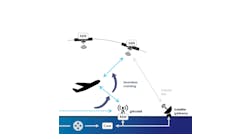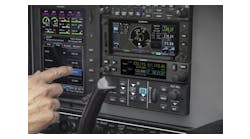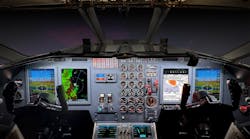One thing I possess in some abundance is time on my hands. This comes with retirement, along with a great number of medications to keep the body going. The Internet, of course, is a great help, not only in passing time, but also in keeping in touch, and in keeping up with developments in our industry. Google Earth is one of the things I use, and I have watched my old apartment house in New York City being demolished and have seen a high-rise take its place. I have also seen airports change from the times I worked at them, and visited as a starry-eyed airplane lover. Most have changed beyond all recognition or, in some cases, disappeared under urban sprawl.
Memories of New York
LaGuardia Field was the most accessible when I was a kid. A couple of nickels each way paid for subway and bus, and another got you onto the observation deck where you could see the planes being loaded and taxied. You could see out to the runway, too, and could watch the DC-3s. That terminal is long gone. The hangar where I taught DC-9 systems to mechanics is gone too, obliterated by the need for additional airline terminals. I wonder if the roadway and ramp were finally stabilized. The airport had been built on fill and reputedly garbage, too. The old hangars, built by the WPA back in the 1930s, were built on wider piles, and did not sink. The ramp in front and the roadway at the back were not. They sank, and it was a considerable upslope run to get an aircraft into the hangar. On the street side, what were once street-level entrances were later accessed by a flight of stairs as the street fell away.
The old Marine Air Terminal is still there, but behind it I see no sign of the the rail tracks that led out of Flushing Bay up the seaplane ramp and into the Pan American hangars. Gone, too, are the wheeled cradles where the big Boeing boat perched. Gone is the ability to stand at a hedge and have airliners swoop low overhead as they landed. Boeing stratoliners, Constellations and DC-3s, DC-4s and DC-6s were predominate in the 40s. An occasional North Star would sing a different tune from its in-line Merlins, rather than the throaty roar of the round radials. Imagine standing at the approach end of runway four, accessible to anyone with legs able to walk there, separated from the runway only by a low hedge.
Security was not the same in the late 40s and 50s. We used to walk over and watch the planes land during our lunch break at the Academy of Aeronautics, where I earned my licenses. It is still there but renamed as Vaughn Technical College. The school’s facade has changed from its 1939s look.
Over at Floyd Bennett Field, New York City’s first municipal airport, only the NYC Police Department maintains a live aviation presence with their helicopters. As a CAP cadet, I first flew from here in 1948, aboard no less than a Douglas A-26 bomber — heady stuff for a 14-year-old. I am pleased to note the old municipal terminal building, used later to house the National Guard operations, still stands. Across the field, in what we called “The Navy Side,” there is no trace of the lines of Hellcats, Avengers and PBY Catalinas I saw back in 1948.
At Newark Airport the old terminal from the 1930s still remains, but has been moved from its original location. Looking at Google Earth, I was able to find the Eastern Terminal where I had my office. My son recently flew out of that terminal, and told me that the moving sidewalk going out to the gates is still broken. So some things remain the same, even under new management.
Changes at Kennedy
Kennedy Airport, of course, is where I started work as a lowly stockchaser on midnight shift at Lockheed Air Service. It was Idlewild International then, and Hangar 7 had just recently opened. Its unfinished look, still evident after 57 years, came from the sight of the uncovered and bare steel beams that formed the roof trusses used to suspend the canteliver roof. No longer used for aircraft maintenance, it is instead an air freight depot. I zoomed in close on Google Earth. The auto shop building is gone. The “Iron Bone Yard” that was located behind it is gone, too.
A world-class collection of aircraft towbars once resided there. Lockheed had bought out Willis Rose some years before, and inherited its collection. When a corporate B-25 visited one day and had to be moved, one of the old timers took me back there and pointed out the proper towbar. Of course, no one ever thought of painting the identification on the bars. I asked what some of the others were for. I was impressed with his knowledge as he pointed out the bar for towing B-17 flying Fortresses, another for the B-24 Liberator, and yet another for the Lockheed Lodestar. In passing, he also nodded to the one for the Curtiss C-46 and the DC-3, both of which I knew, as I had used them. The Lord alone knows what else was back there; the collection had come from Roosevelt Field, which itself dates back to 1921. Some towbars were long bridge-truss structures, made to reach back under the rear of tail dragging aircraft to hook onto tailwheels. They had to be long to clear the aircraft horizontal stabilizer and elevators. Some were pairs of long pipes with shackles that spread out to attach to the main landing gear. All, however, were rusty now, unloved and vainly waiting for the return of their probably extinct aircraft.
I scanned around and vainly looked for any sign of the bowsers, engine preoilers, prop dollies, and other equipment that also populated the boneyard behind the auto shop.
Gone were the forest of ladders, engine docks, stands and the like that sat there awaiting repair. Missing was the blower with the towerlike tall pipe sticking straight up from it, which was used to push air through the DC-4 cabin heater for ground testing. All gone, even the oil stains on the ramp from the dripping engines of the Connies and Douglas products that once populated the ramp. Forty years of rain and snow had obliterated them.
There were still aircraft there dotting the ramp, but now all with swept wings. They had their main-deck cargo doors gaping and pallets and containers were nearby waiting for loading.
Gone, too, was the Farmall tractor that was so terrifying to drive. It had no seat; one stood on a rear platform like a Roman chariot driver and tried to gently let in the clutch. Too fast a release and a little rev of the engine caused the front of the tractor to rise off the ground like a rearing horse. The Oliver tractor was gone, too, and so was the Silent Hoist jet tug that resembled an aircraft carrier, complete with its island cab on the starboard side. It, too, had its little quirks like the steering-wheel shaft splines, which would decouple when a sharp turn needed to be made. It happened to one of the auto shop people as he drove some miles from the terminal to the hangar via the service road. He was stopped by the chain-link fence, however.
No use in looking for the Eastern Hangar 9; it has been torn down, as has the Eastern terminal. Both were, in my humble opinion, bad buildings. The hangars suffered from huge settling cracks. The base had apparently not been properly prepared when it was built. In this case, the building sagged and cracked as it settled. This was the opposite of the LaGuardia hangar, where the building did not settle, but the land, and so the ramp and street, did. The terminal was built in the days before security was thought of, and the passenger holding areas at the gates were far too small for the widebody airliners that came along. Because the gates were at ramp level, it was difficult to add loading bridges. In actual fact, you had to climb stairs to get up to the loading bridges themselves. The baggage sorting areas were cramped, too.
Outside, the ramp itself had been designed for maximize drainage. This meant that some parts of it were quite sloped, making it difficult to fuel some aircraft to maximum without suffering overflow from the airplane vents. The employee cafeteria, however, was quite good. For that, I can forgive much.
Also among the landmarks missing from the JFK area appears to be the Airport Diner, which was over on Rockaway Boulevard. I ate a lot of midnight-shift meals there when working at Lockheed. I also find no listing for the Owl Tavern, except historically. It would appear that some of the criminals taking part in a huge gold robbery from an airline frequented the tavern.
This, according to online sources, prompted FBI agents to stop by often, probably not to eat a slice or two of pizza. I am sure it did not encourage business.



